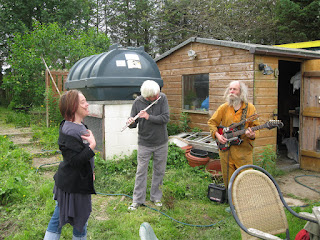Among my earliest memories is trying to find a place to sit down in a living room jammed full of
holly. Piles of it, some cut into sprigs, some with wires wound around the
stem, green holly, variegated, berries, wires. My dad
sat among the piles, a circle of moss balanced on one hand, and with
the other hand he stuck holly sprigs into the moss. First he planted a complete circle of cypress sprigs,
then three rows of holly, inserted at three different angles to fill up the circle. Finally he inserted several sprigs of variegated holly and berries. The
wreaths were all pleated during the long winter evenings. To keep our stone cottage warm, we burned a paraffin stove. Every couple of hours I had to run into the frosty night to fill up a jar with paraffin and insert it into the stove to keep it running. I also wound wires around the holly stems. Later on, I made a few wreaths to earn some Christmas money.
While he worked,
he told us stories.
We heard about his adventures in the POW camp. The compound was
along the lines of the camp in the film, The Great Escape. Perhaps it was a harrowing
experience, but he made it sound like an adventure. At times funny, especially
how the prisoners sometimes got the better of their captors. A few, not many, escaped in ingenious ways. Yes,
they dug an escape tunnel, and almost completed it, but in the end decided not to use
it. War was ending and the prisoners realized that they had more to gain by waiting until they were released.
There were family stories, memories of growing up in a manor house on the banks
of the Pripyat River
What I didn’t realize at the time was that during winter, when
the Old Scone Nursery had little else for sale, the wreaths provided most of
the winter income. Making each one took about two hours, but they fetched a
good price in the Perth shops.
Also, materials were cheap. The moss came out of the local woods. As for the holly,
well that was a family secret. Enough to say that the nearby palace garden contained many holly bushes. Each winter they received a severe haircut. Finally
the local Factor, not amused by the stunted look of his holly trees, told my dad to
cease and desist. He had to look further afield. Hardest to find were holly
berries. In a bad year, my dad had to substitute plastic ones.
This year I bought the metal rings and made a few wreaths for gifts. Remarkably I recalled the entire process as if I'd done it yesterday: the order of the rows, the angles for the holly, that the variegated holly and the berries get longer wires. The wreaths turned out exactly as I remembered. No one makes them that way any more. Modern wreaths have pine cones, plastic holly and fir tree sprigs.
Where did my holly
come from? My dad used to reply to such a question with, “It’s better not to
say”. I'll stick to that line.










































